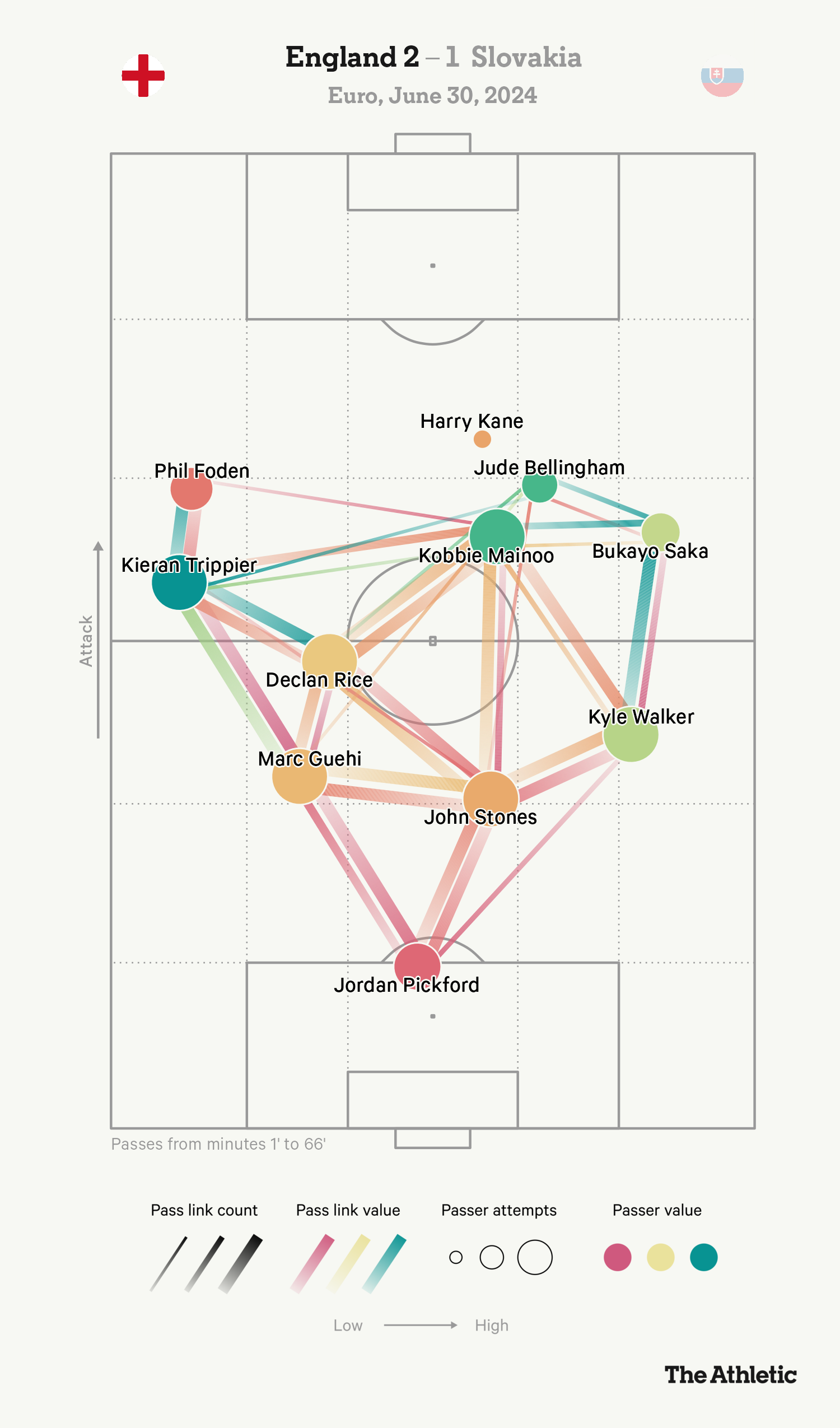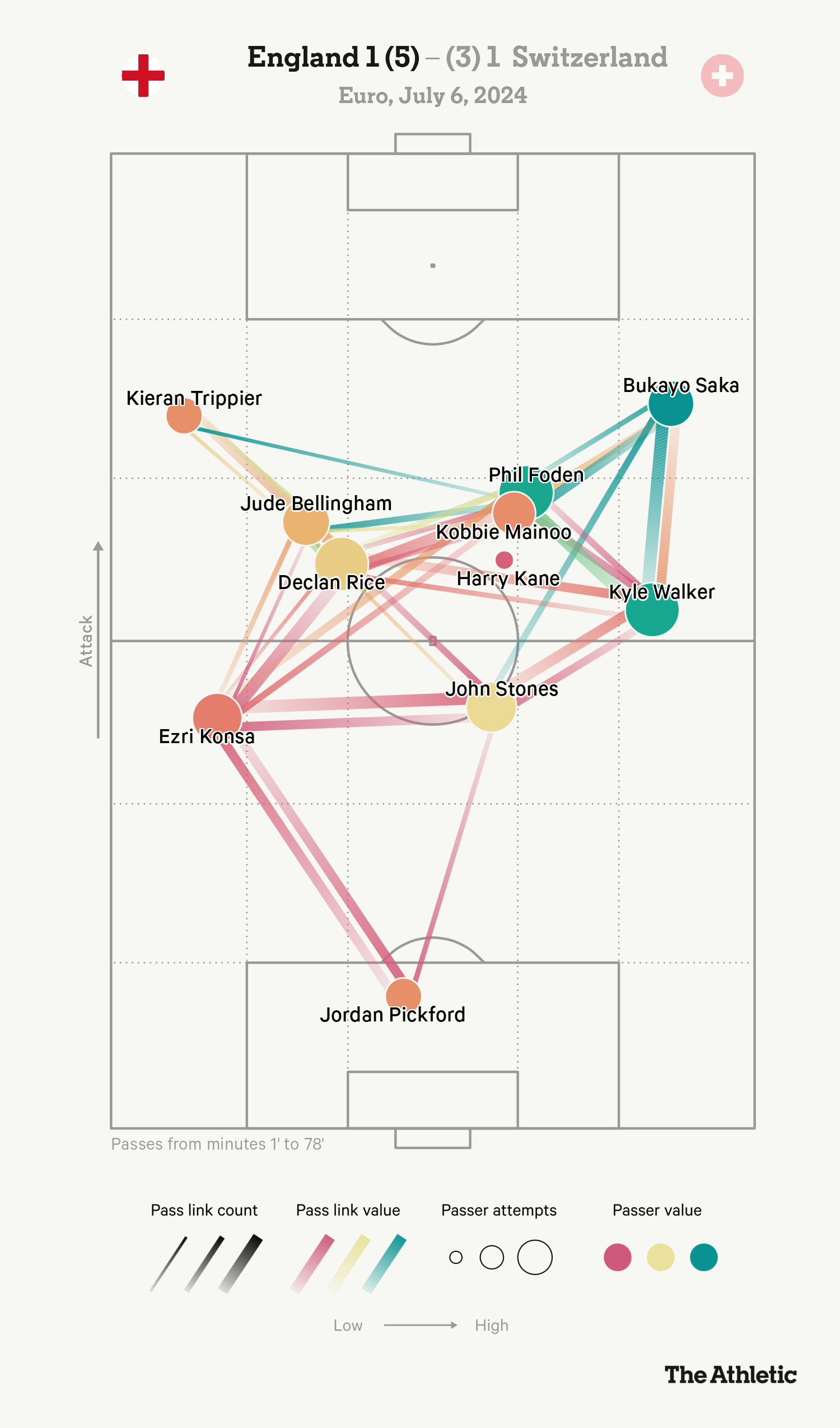It wasn’t convincing. England very rarely are these days. But they are in the semi-finals of a major tournament for the third time in four tournaments under Gareth Southgate, after beating Switzerland 5-3 on penalties.
Southgate substitutions: what should we make of them?
Southgate should have made his changes earlier, probably at some point after the 65-minute mark when it was clear England’s momentum was waning. The charge remains that he is too passive, nowhere near proactive enough as an international coach when the right changes at the right time are crucial. But the introduction of Cole Palmer, Eberechi Eze and Luke Shaw did make England much more dynamic and balanced.
The changes revamped England’s left side, Shaw giving the back three a natural left footer, Eze much more dynamic in attack than Kieran Trippier and Palmer providing more creative imagination.
At the same time, it’s true England did have to rely on a moment of brilliance from Saka to stay in the game. If you were being extremely generous you could say that stretching the game from the left allowed enough space for Saka to exploit on the right. But that doesn’t give the Arsenal man enough credit: he saved England more than Southgate did.
The changes also helped with penalties though, with Cole Palmer and Ivan Toney take cool spot-kick during the win to continue England’s progress through the tournament.
England’s major championship penalty record
- 1990: World Cup Semi-Final vs Germany – Lost 4-3
- 1996: European Championship Quarter-Final vs Spain – Won 4-2
- 1996: European Championship Semi-Final vs Germany – Lost 6-5
- 1998: World Cup Last 16 vs Argentina – Lost 4-3
- 2004: European Championship Quarter-Final vs Portugal – Lost 6-5
- 2006: World Cup Quarter-Final vs Portugal – Lost 3-1
- 2012: European Championship Quarter-Final vs Italy – Lost 4-2
- 2018: World Cup Last 16 vs Colombia – Won 4-3
- 2020: European Championship Final vs Italy – Lost 3-2
Saka stars… but where is Kane?
When Saka starts well, England start well. He was their best player in the first half against Serbia, when he repeatedly had the beating of Andrija Zivkovic, and today he was again. It was no coincidence that the first half here was England’s best half since they started the tournament almost one month ago. Pushed high and wide in possession, in a formation that almost looked like a 3-4-3, Saka was up against Swiss left wing-back Michel Aebischer. And he had him on toast.

(Alex Livesey/Getty Images)
4 – Bukayo Saka successfully dribbled past Michel Aebischer four times in the first half, already the most one player has beaten another in a single match at #EURO2024. Penetration. #ENGSUI pic.twitter.com/7rxQBue3fD
— OptaJoe (@OptaJoe) July 6, 2024
So many times in the first half Saka had the beating of Aebischer, taking advantage of the fact that England were getting the ball to him far faster than they had been against Slovakia. Saka got into good positions, got crosses in, forced corners. The only frustration was that England were never able to turn any of those crosses into serious shots on goal. Harry Kane, who was prone to dropping deep throughout the match, ending up deep in defence at points in the second half, was unable to get on the end of any of his deliveries. He was later substituted in extra-time after an accidental collision with Southgate.

(James Baylis – AMA/Getty Images)
Without the ball Saka had to run back and cover Ruben Vargas but he did that diligently. And when England needed him most, Saka delivered with the crucial equaliser, just when England looked completely out of ideas.
Jack Pitt-Brooke
Shape-shifters
A lot of discussion swirled around Gareth Southgate’s decision to switch formation ahead of this clash, with the potential of giving England greater balance in wide areas with a naturally left-footed left wing-back (Saka) and a naturally right-footed right wing-back (Kieran Trippier).
As it turned out, Saka and Trippier remained in their inverted roles within a 3-4-2-1 system that saw the greatest change in the No 10 positions — with Jude Bellingham and Phil Foden switching sides.
England’s pass network from their game against Slovakia was not too dissimilar to that of the Switzerland clash — with Kyle Walker maintaining a narrow position to build with a back three, with a double pivot, two players wide and two inside behind Harry Kane.

The most notable change was unlocking the potential of Foden, who was released from a left-sided role to a more familiar, dominant role he has played for his club last season as an inside-right attacker.
“For me, it’ll be more central,” Foden revealed before the game. “Staying more inside, what I prefer anyway — I like to be in there.”
Foden was dropping deep to pull the strings at times, while being able to drift inside more naturally onto his left foot. Looking at England’s pass network against Switzerland before their first substitution, the overall in-possession shape was not wildly dissimilar from their last-16 clash — maybe excluding Harry Kane’s strange average position.

The tweak was more subtle than we expected, but the change was a net positive for Southgate’s side.
Mark Carey
Pressing concern
Gareth Southgate’s was acutely aware of the danger that Switzerland would pose in and out of possession, which was a key factor in England’s system switch.
Against Italy, Switzerland penned Italy in and forced them into mistakes, herded them towards the touchline, or squeezed them to play the ball into central areas where they could hoover up loose balls before starting another wave of attack.
It was a clear plan from Swiss manager Murat Yakin who knew his side’s strengths out of possession, saying: “I knew that if the Italians came with a back four, we would destroy them.”
Against England’s tweaked system, the Swiss press was not as relentless — or effective — in regaining the ball in high areas, particularly in the first half. England’s numerical superiority in build-up allowed them to work the ball out with greater success at times, but that was coupled with the variety that Jordan Pickford offered when he had the ball.
Sometimes he would go short into his centre-backs, but he was not afraid to ping it long and bypass the initial Swiss press, allowing England to work the ball upfield more directly — especially with Saka and Trippier staying high as wing-backs and pinning Swiss wing-backs towards their own goal.
The numbers back it up. Compared with Switzerland’s 16 shots and five regains in the attacking third against Italy, they were restricted to just six shots and three high regains against Southgate’s side in regulation time. Broadly speaking, England kept the Swiss guessing in their build-up, casting doubt on when to jump and when to retreat.
Mark Carey
Mainoo makes difference
There was a moment in the first half when Kobbie Mainoo received a pass inside the England half, facing his own goal and with both Remo Freuler and Granit Xhaka closing in on him from behind in a pincer movement. Mainoo could only have been peripherally aware of where his opponents were, but he paused for a fraction of a second, dropped his right shoulder and swivelled his hips, allowing the ball to run across his body.
Xhaka and Freuler tried to screech to a halt like a couple of cartoon villains given the slip by Wile E Coyote, but Mainoo was off, driving through the now vacant middle of the pitch, having created an attack from essentially nothing.
That was the most eye-catching thing that the Manchester United midfielder did, but the rest was just as valuable. He has that ability specific to a lot of top level footballers, an ability to slow the game down, as if he goes into his own personal mind palace while everyone else is dashing here and there around him. He barely seems to make a bad decision, rarely wastes a pass. And he’s 19. It hardly seems fair, really.
Nick Miller
Recommended reading
(Top photo: Alex Livesey/Getty Images)
Read the full article here


